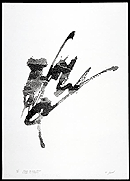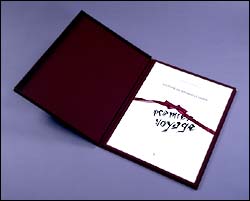
|

Fresque no 1 (detail), 2000 (Fresco no. 1) From the series L'Avant-Babel (Before Babel) Silkscreen prints on fabriano paper Limited edition of six numbered copies Lent by the artist (Photo: Harry Foster. © Canadian Museum of Civilization Corporation) " For L'Avant-Babel, I mixed together different alphabets originating in the East, the Far East, Europe, the Mediterranean basin ... for example, Arabic, Chinese, Latin, Cyrillic and pictographs. By memorizing these alphabets and writing them in a style that resembles calligraphy, I want to arrive at a spontaneous gesture ... while trying to create a kind of harmony in the writing, as if it were a single language. [...] What I am trying to do is very utopian, for a universal
writing is not the same thing as a universal language; each language has
its own way of thinking ... " Extracts from an interview with the artist Taouffik Semmad was born in Algiers in 1957. He left Algeria after completing his studies at the École des beaux-arts. After living as a resident student in the former Soviet Union, he also lived in Belgium for a period of 14 years, where he acquired formal training in graphic communications and typography as well as in engraving. In 1995, he settled in Montreal.  Taouffik Semmad, Westmount, Quebec, 2000 Rawi Hage Gelatine silver prints Collection of the Canadian Museum of Civilization A calligrapher, illustrator and engraving artist, he earns his living by working as a graphic designer and typographer, notably by hand-drawing fonts (which distinguishes him from his colleagues who perform this work with computers). This specialization allows him to bridge the gap between Arabic-Persian tradition (miniatures, classical calligraphy) and graphic design and publishing. Taouffik Semmad's art works-illustrations, paintings, engravings-embody his fascination with the "sign" and handwriting in all its forms. In a work entitled L'Avant-Babel, he plays with the utopian idea of creating, through calligraphic gesture, a universal form of writing based on the use of multiple alphabets. A rather modern subject, he explains, that is inspired at the same time by an ancient tradition . . . a personal interest in the world and in an understanding among peoples. 
Artist's book - Les Mille et une nuits : Histoire de Sindbad le marin, premier voyage, 1999 (The Arabian Nights: Story of Sindbad the Sailor, Maiden Voyage) Aquatints on holland simili japan paper, silkscreen prints on holland simili japan paper and translucent drawing paper Copy no. 1 in a case handmade by the artist Limited edition of seven numbered copies Lent by the artist (Photo: Harry Foster. © Canadian Museum of Civilization Corporation) In another project, an artist's book, he depicts the "Story of Sindbad the Sailor" (maiden voyage) from The Arabian Nights. In this piece he is inspired as much by his own experience in life as by the narrative: he graphically translates travels, restless wandering and the meeting of cultures into an "abstract" calligraphy that combines various Eastern and Far Eastern alphabets and ideograms. What fascinates me in calligraphic writing is the gesture. There is an outpouring, a spontaneity, and an element of the unconscious that surfaces, all at once. A member of the Conseil québécois de l'estampe, Taouffik Semmad has exhibited his art in Algeria, in the former Soviet Union, in Belgium and in Canada. http://www.identifont.com/show?1QK http://www.itcfonts.com/fonts/detail.asp?sku=ITC2017 |